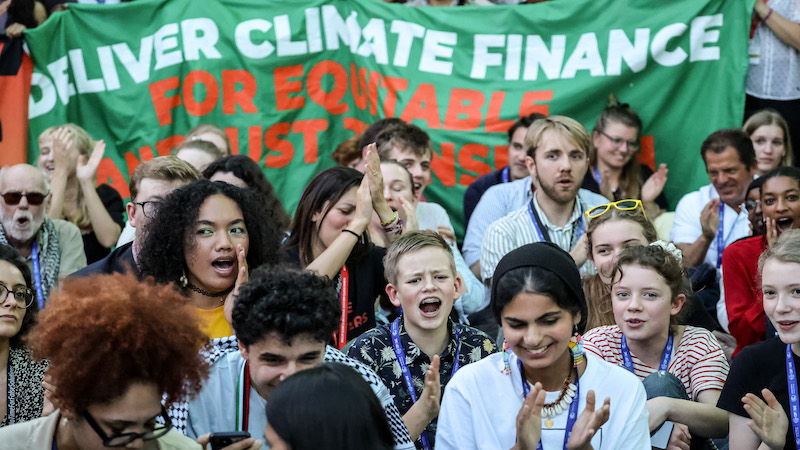Developed countries have pledged to spend around $116 billion on climate change in 2022, but experts and activists have questioned how the targets are being met.
Developed countries will meet their long-standing pledge to provide at least $100 billion a year in climate finance to developing countries for the first time in 2022, according to official figures released Wednesday, two years later than originally promised.
The failure to meet the target by the deadline is a sore point in U.N. climate change talks and is fuelling mistrust between rich governments and poorer countries struggling to cover the costs of switching to cleaner energy and adapting to the worsening effects of climate change.
Developed countries provided and mobilized $115.9 billion in climate finance for developing countries in 2022, up from $89.6 billion in 2021, according to the latest data from the Organisation for Economic Cooperation and Development (OECD).
Mathias Cormann, a former Australian treasurer and OECD secretary-general, said “exceeding” the annual pledge was “an important symbolic achievement that makes up to some extent for two years of delay” and “should help build confidence.”
The roughly 30 percent increase from last year is the largest ever and was driven by a significant increase in financing from multilateral development banks (providing up to $50.6 billion), national governments, and private capital mobilized using public funds to mitigate investment risks.
Climate finance analysts have criticised the quality of climate finance and the way the OECD's figures were calculated.
Veteran climate justice activist Harjeet Singh said the process for providing and accounting for climate finance is “full of ambiguity and inadequacies” — a long-repeated complaint by developing countries, which have called for greater clarity and transparency on how the numbers are calculated.
“Much of the funding has been repackaged as loans rather than grants and is often intertwined with existing aid, blurring the lines of true financial support,” Singh said.
According to the OECD report, in 2022, as in the previous year, official climate finance will mainly be raised in the form of loans, accounting for 69% or $63.6 billion. Not all of the loans were on preferential terms, and some were on market terms.
In contrast, subsidies amounted to just 28% of the total, or $25.6 billion, and equity investments were a much smaller $2.4 billion.
Renaming development aid?
Climate finance experts have also raised concerns that donors will divert existing aid funds to meet the $100 billion target: A recent analysis by the Washington-based think tank Center for Global Development estimated that more than a third of the funding provided by developed countries in 2022 will come from existing aid funds.
“Much of the increase is due to donors expanding, redirecting and reclassifying existing development funding,” said Ian Mitchell, senior policy researcher at CGD and one of the report's authors.
In February, an independent watchdog found that the UK had earmarked an extra 1.7 billion pounds ($2.15 billion) towards its 11.6 billion pound climate finance target without giving more money to vulnerable countries, primarily through disguising other forms of aid to counter financial pressures related to the COVID-19 pandemic.
How donor climate financing will be counted and tracked will be part of negotiations this year on new finance targets due to be agreed at the COP29 climate summit in Azerbaijan in November.
The New Common Quantitative Target on Finances (NCQG) is the most significant decision expected to be adopted at this year's COP, replacing the current $100 billion commitment that expires in 2025.
Experts believe an ambitious agreement will play a key role in getting developing countries, especially the poorest, to commit to stronger action on emissions reductions and adaptation when new national climate plans are drafted, due in early 2025.
Melanie Robinson, GDirector of Global Climate, Economics and Finance Jonathan McCain, president of the World Resources Institute, said filling the funding gap for poorer countries should be a “top priority” for NCQG negotiations at COP29, but success will not depend alone on securing funding. Much larger top-line amounts.
“For example, INew climate finance target Guarantee Funds are available; do not burden on developing countries and more Unsustainable She said, “Debt.” Strong measures report progress, Hold countries accountable to meet their obligations on time Increasing transparency in climate finance.
“Adaptation Finance Progress”
In addition to simmering tensions over donor pressure from rich countries and disagreements over whether the new goal should include a wide range of climate finance sources, the most vulnerable countries are calling for specific targets for adaptation finance.
Even though climate impacts are happening faster than scientists predicted, funding to help countries adapt their economies and societies to extreme heatwaves, droughts, storms, floods and rising sea levels has consistently lagged far behind investments in clean energy and other emissions-reducing measures.
Under pressure at the COP26 climate change conference in 2021, developed countries have urged each other to at least double their adaptation funding to developing countries by 2025, up from the roughly $19 billion they provided in 2019.
OECD figures released this week showed adaptation finance from developed countries had risen to a record $28.9 billion at the midpoint of 2022, with a further $3.5 billion mobilised from the private sector.
The Paris-based watchdog said progress towards meeting the targets “has been seen and needs to be sustained.”
Activist Singh said climate-vulnerable people and ecosystems needed urgent action from developed countries and to provide “substantial financial support”.
“It's not just about numbers, it's about sincerity and real support,” he added. “As things stand, the funding needs for developing countries to transition away from fossil fuels and address climate change are skyrocketing to trillions of dollars.”
(Reporting by Megan Rowling and Matteo Sibillini; Editing by Jho Low)


